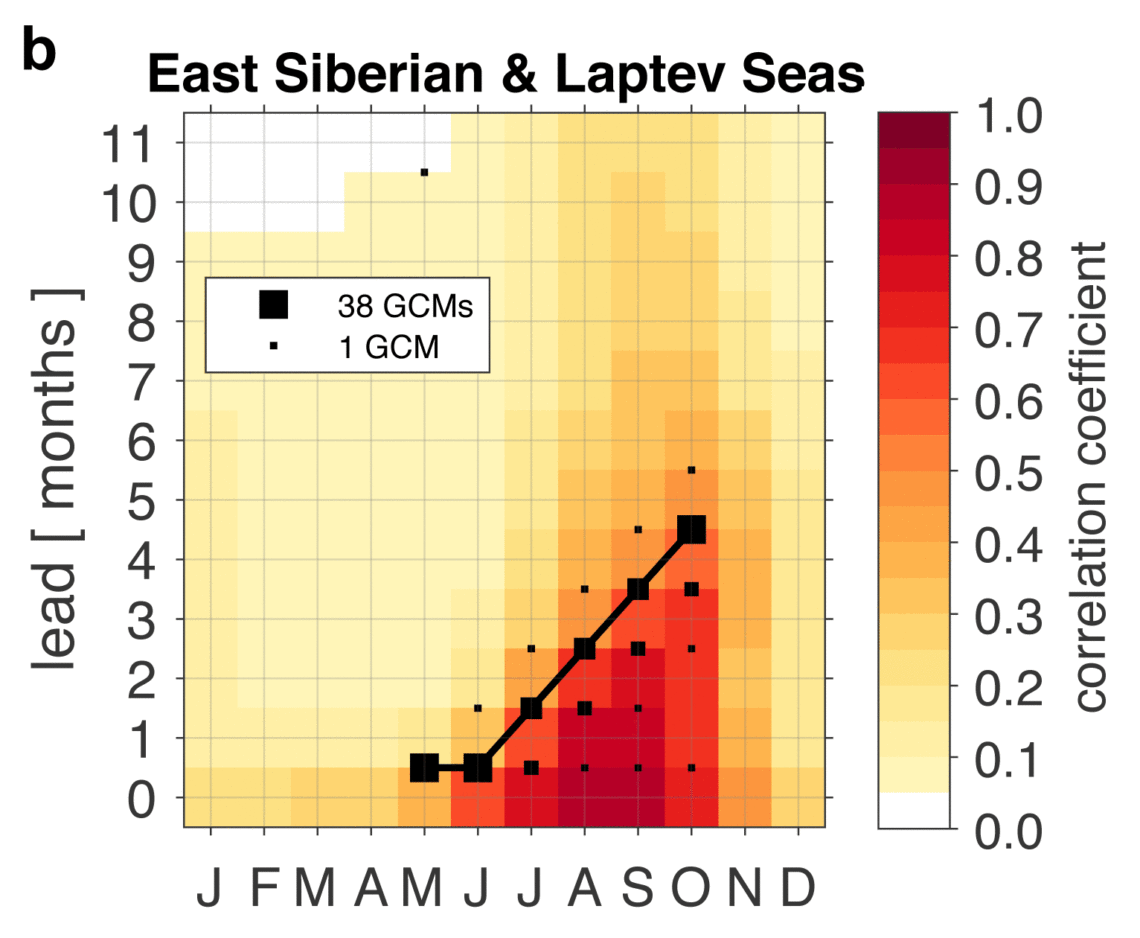August 1st, 2019
Key Findings
- Sea ice volume is a skillful linear predictor for summer sea ice area in the Arctic and accounts for most of the summer prediction skill
- Nearly all CMIP5 models exhibit a spring predictability barrier for summer sea ice in the marginal seas of the Arctic basin
- Sea ice forecasts for these regions initialized prior to June 1 will have substantially less skill than forecasts initialized afterwards.
David Bonan, Mitchell Bushuk, Michael Winton. Geophysical Research Letters. DOI: 10.1029/2019GL082947
A central goal of the sea ice research community is to assess the ability of climate models to accurately predict Arctic sea ice. A broad range of stakeholders have a pressing need for regional forecasts. Previous studies assessing sea ice prediction skill suggest that some regions in the Arctic have a “prediction skill barrier” in the spring season, where predictions of summer sea ice made prior to May are substantially less accurate than predictions made after May. However, this barrier has only been documented in a few climate models. This study employs a simple model that uses sea ice volume to predict summer sea ice area. After showing that this simple model reliably predicts regional Arctic sea ice area in the summertime, the authors test for this barrier across a range of climate models and find that a spring predictability barrier exists across nearly all climate models. This suggests that there may be a fundamental limit on skillful predictions of summer Arctic sea ice at regional scales, where forecasts made prior to June 1 will be substantially less accurate than forecasts made after June 1.
The simple linear regression model employed in this study uses regional Arctic sea ice volume (SIV) to predict regional Arctic sea ice area (SIA), to quantify summer SIA predictability across an ensemble of climate models participating in phase 5 of the Coupled Model Intercomparison Project (CMIP5). The authors first show that SIV is the source of prediction skill for summer SIA by comparing the lead-time correlations of SIV and target month SIA to a skill metric from a set of perfect model experiments (which characterizes the upper limits of SIA predictability). This comparison demonstrates that SIV alone can characterize regional summer sea ice predictability in the Arctic with high skill. Notably, the correlations of SIV and SIA capture the spring predictability barrier that has been identified in previous studies. In these studies, climate models that are initialized prior to May are found to lose SIA prediction skill more quickly than models initialized after May. Since this comparison associates the spring predictability barrier with correlations of SIV and SIA, the authors assessed Arctic sea ice predictability across a larger swath of models where SIA and SIV can be readily calculated from the CMIP5 output.
It is important to note that although this spring barrier has been found in a previous set of studies, it has only been quantified in two climate models. It remains unknown whether this spring predictability barrier exists across other models. Building on this previous work, the authors examine this barrier across the suite of pre-industrial control experiments from CMIP5 and find that this springtime predictability barrier is remarkably universal across models. Nearly all show substantial prediction skill loss from June to May for summer SIA target months in the East Siberian and Laptev Sea. Investigating this barrier across other regional domains, we find that this spring predictability barrier exists for SIA in the marginal seas of the central Arctic Ocean (i.e., Kara Sea, East Siberian Sea, Laptev Sea, Beaufort Sea, and Canadian Archipelago). Importantly, these regions encompass most viable summer shipping pathways, which suggests this barrier may limit accurate forecasts for end users.
This study offers unique results regarding Arctic sea ice predictability that are relevant for stakeholders who care about operational sea ice forecasts. Because this spring predictability barrier is universal across climate models, there may be a limit to accurate forecasts of Arctic sea ice concentration. Models initialized on June 1st or later will be substantially more accurate than models initialized before (e.g., May or April). As such, the authors suggest that the observational community and forecasting community work together to develop an observationally-constrained data set of sea ice thickness near June 1 (which is past the barrier). Since Arctic sea-ice thickness is the source of skill for summer sea ice predictions, a better initial state of ice thickness that is past this barrier will provide numerous benefits to end users. Currently, the algorithms that derive Arctic sea ice thickness stop in mid-April, which occurs considerably before this barrier and may limit accurate forecasts.



